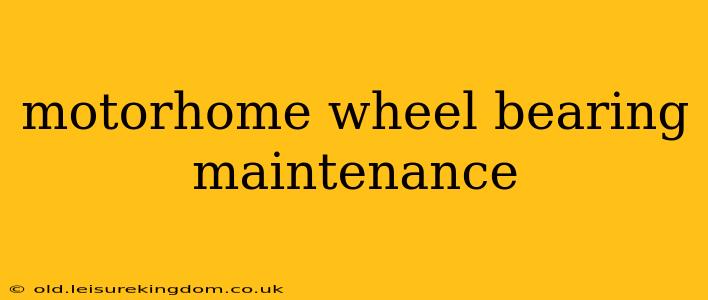Maintaining your motorhome's wheel bearings is crucial for safe and reliable travel. Neglecting this essential maintenance can lead to catastrophic failure, potentially resulting in accidents and costly repairs. This comprehensive guide covers everything you need to know about motorhome wheel bearing maintenance, ensuring your journeys are smooth and trouble-free.
What are Wheel Bearings and Why are They Important?
Motorhome wheel bearings are precision components that allow the wheels to rotate smoothly and efficiently. They reduce friction between the rotating wheel hub and the stationary axle, preventing excessive wear and tear. These bearings are subjected to significant stress, especially during long journeys and heavy loads. Proper maintenance is vital to extend their lifespan and prevent dangerous failures. Ignoring this maintenance can lead to overheating, seizing, and ultimately, complete bearing failure, causing loss of control of your vehicle.
How Often Should I Inspect My Motorhome's Wheel Bearings?
This is a crucial question with no single definitive answer. The recommended inspection frequency depends on several factors, including your driving style, the terrain you typically travel on, and the overall condition of your motorhome. However, a general guideline is to inspect your wheel bearings at least once a year or every 10,000 to 12,000 miles, whichever comes first. More frequent inspections are advisable if you frequently tow heavy loads or drive on rough roads.
How Often Should I Replace My Motorhome's Wheel Bearings?
This depends greatly on the usage and condition of the bearings. There isn't a set mileage or timeframe. However, regular inspection is crucial. If you notice any signs of damage, such as play, noise, or overheating, replacement is necessary.
How to Inspect Your Motorhome Wheel Bearings: A Step-by-Step Guide
Regular inspection is the cornerstone of preventative maintenance. While a complete bearing overhaul requires specialized tools and knowledge, a basic inspection is achievable for most RV owners.
-
Visual Inspection: Carefully examine each wheel for any signs of damage, grease leaks, or unusual wear. Look for any signs of rust or corrosion.
-
Check for Play: Gently grab the top and bottom of the tire and try to move it from side to side. Any noticeable play or looseness indicates a potential problem with the wheel bearings.
-
Listen for Noise: While jacking up the wheel, rotate the tire by hand. Listen carefully for any unusual sounds such as grinding, clicking, or humming.
-
Check the Temperature: After driving for a while, carefully feel the wheel hubs. Excessive heat indicates potential bearing problems.
What are the Signs of Failing Wheel Bearings?
Several indicators can suggest your wheel bearings are failing. Recognizing these signs early can prevent more serious problems.
- Unusual Noise: Grinding, humming, rumbling, or clicking sounds emanating from the wheels are telltale signs.
- Vibration: Increased vibrations in the steering wheel or chassis during driving.
- Excessive Heat: Wheels noticeably hotter than others after driving.
- Wheel Play: Noticeable looseness or play when attempting to move the wheel side to side.
- Grease Leaks: Grease leaking from the hub seals.
What Causes Wheel Bearing Failure?
Several factors contribute to wheel bearing failure:
- Lack of lubrication: Insufficient or improperly applied grease leads to friction and wear.
- Water contamination: Water ingress into the bearings causes rust and corrosion.
- Overloading: Exceeding the vehicle's weight capacity puts excessive stress on the bearings.
- Rough roads: Driving on bumpy roads creates increased stress and wear.
- Lack of maintenance: Neglecting regular inspections and lubrication.
Can I Replace Motorhome Wheel Bearings Myself?
Replacing wheel bearings is a complex task that requires specialized tools and mechanical expertise. Unless you have significant experience working on automotive components, it's best to leave this task to a qualified mechanic or RV specialist. Improper installation can lead to further damage and safety hazards.
How Much Does Wheel Bearing Replacement Cost?
The cost of replacing wheel bearings varies depending on several factors including labor rates, the type of motorhome, and the parts required. It's best to contact a qualified mechanic or RV repair shop for an accurate estimate.
How Can I Prevent Wheel Bearing Failure?
Preventative maintenance is key to avoiding costly repairs. Regular inspections, proper lubrication, and adherence to manufacturer recommendations are crucial steps in maintaining the integrity of your motorhome's wheel bearings. Remember to always use the correct type and quantity of grease specified by your motorhome manufacturer.
This comprehensive guide provides a solid foundation for understanding and maintaining your motorhome's wheel bearings. Remember, prioritizing regular inspections and professional service when necessary ensures safe and enjoyable travels.

